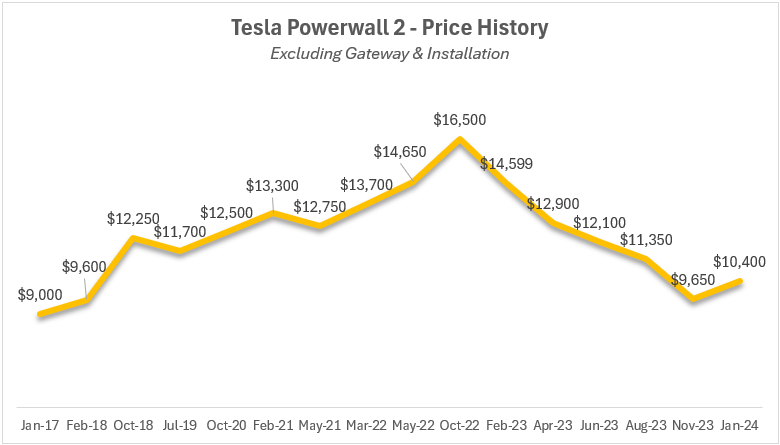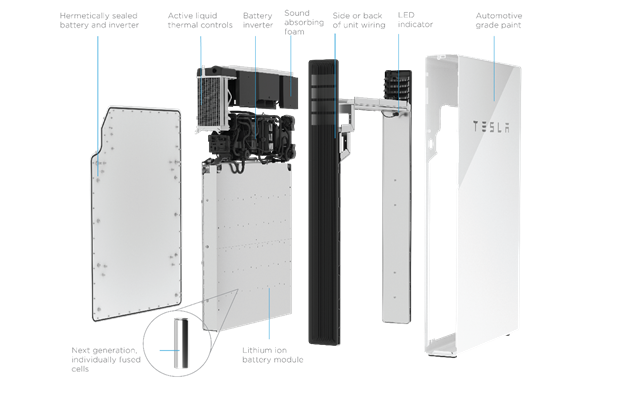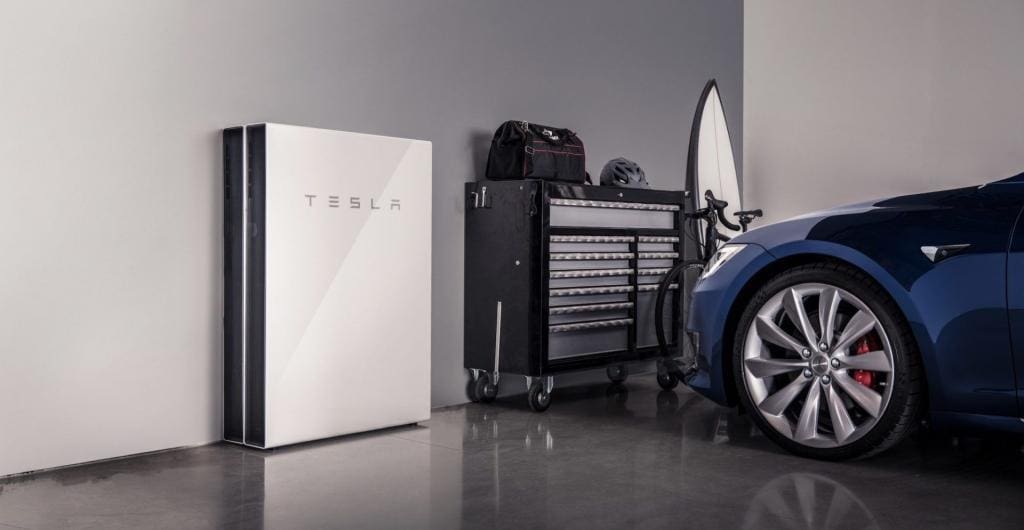The world-famous Elon Musk, CEO of Tesla, announced an entry into the energy storage market in 2015 with the launch of the home battery product, the Tesla Powerwall.
Perhaps more famous for their electric vehicles, Tesla Motors have been praised for their ability to make leaps and bounds in research and development.
Tesla Australia has attempted to make leaps in the energy sector recently with the newer version of the Powerwall.
How Much Does The Tesla Powerwall 2 Cost?
In Australia, across our network of over 150 solar installers, we expect this installed cost of a Tesla Powerwall 2 to cost around $13,000 to $15,000 including the gateway, delivery, installation and any other required electrical components.
In 2017 the Tesla Powerwall 2 launched with the cheapest price point at $9,000 for 13.5 kWh making it one of the most cost-effective options in the residential battery market.
Since then, initially, high demand and higher production costs led to the wholesale cost of the battery reaching $16,500 in 2022.
Since the start of 2023, Tesla has dropped the price of the Powerwall 2 by 42% to $9,650 including GST after Tesla’s $750 rebate.
Tesla is expected to launch the Tesla Powerwall 3 in 2024, so are likely trying to get rid of all remaining Powerwall 2 stock.
Tesla Powerwall 2 Price Change History (excluding Gateway):
| Date | Wholesale Price | Change |
| 2017 | $9,000 | |
| 2018 – February | $9,600 | +$600 |
| 2018 – October | $12,250 | +$2,650 |
| 2019 – July | $11,700 | -$550 |
| 2020 – October | $12,500 | +$800 |
| 2021 – February | $13,300 | +$800 |
| 2021 – May | $12,750 | -$550 |
| 2022 – March | $13,700 | +950 |
| 2022 – May | $14,650 | +$950 |
| 2022 – October | $16,500 | +$1,850 |
| 2023 – February | $14,599 | -$1,901 |
| 2023 – April | $12,900 | -$1,699 |
| 2023 – June | $12,100 | -$800 |
| 2023 – August | $11,350 (after rebate) | -$750 |
| 2023 – November | $9,650 (after rebate) | -$1,700 |
| 2024 – January | $10,400 | +$750 |
Or in a visual form – you can see the trend in the graph below:

Whether the Tesla Powerwall 2 is a cost-effective product for your system will depend on a closer examination of your electricity needs.
To see if home solar battery storage is worth it, our detailed Solar Battery Sizing and Payback calculator to see the financials for your system.
Tesla’s official release of the Powerwall 2 & Solar Roof
The Chemistry of a Tesla Powerwall 2

Batteries have a positive cathode, a negative anode and are separated by an electrolyte in a simple view of a battery.
The Tesla Powerwall 2 uses Lithium-ion technology where the cathodes are made from a compound of Lithium, Cobalt, Nickel and Manganese (LiNiMnCoO2).
Other lithium battery chemistries in the on-grid home battery storage market include lithium iron phosphate (LiFePO4) and lithium cobalt oxide (LiCoO2).
The battery comes with a 10-year warranty and provides 5kW of output power, making it suitable for large residential homes. Multiple batteries can be daisy-chained together for commercial use.
The battery is 1.15m by 0.76m and can be wall-mounted indoors or outdoors.
Tesla Powerwall 2 Backup Gateway
The Tesla Powerwall 2 ‘Gateway’ is an additional piece of hardware that is paired with the Tesla battery to enable solar and battery system to perform as back up power during a power outage. Otherwise during a power outage your solar and battery system will turn off until power is restored.
The Gateway prevents power from being sent back into the electricity network during an outage which keeps the lines safe for electrical workers working on the grid.
Some battery manufacturers have this capability built into the battery. Tesla charge an additional $1,700 for their Gateway which is a material additional to the overall cost of the system.
Compare solar and battery quotes from local installers now.
Pros and Cons of the Tesla Powerwall 2
Of course, with any product, there’s the good and the bad. We’ve summarised the key points below for you:
| Pros | Cons |
|
|
Tesla Powerwall 2 Warranty for Australian Customers
The Tesla Powerwall 2 for Australian customers offers two types of warranties: time-based and throughput-based. The time warranty covers defects for 10 years, excluding damages from improper use or installation. It also ensures less than 30% degradation from its 13.2kWh capacity over 10 years. If the battery discharges only 9.2 kWh or less after 10 years, you’re eligible for a warranty claim.
The throughput warranty varies with usage. For typical home use, like storing solar power for evening use or during blackouts, Tesla offers ‘unlimited cycles’. This means about 3,600 cycles over 10 years, assuming one cycle per day.
For other uses, like participating in Virtual Power Plants or off-grid charging, the warranty covers a maximum throughput of 37,000 kWh from the battery’s AC output. This equates to roughly 10 kWh per day, similar to one battery cycle per day over 10 years, considering battery degradation.
Read through Tesla’s full warranty conditions in this document.
Tesla Powerwall 2 Performance Specifications
| AC Voltage | 230V |
| Feed in Type | Single-phase |
| Grid Frequency | 50 Hz |
| Usable Energy | 13.5 kWh |
| Depth of Discharge | 100% |
| Real Power | Max continuous 5kW (charge & discharge) |
| Power Factor Output Range | +/- 1.0 (adjustable) |
| Internal battery DC Voltage | 50V |
| Round Trip Efficiency | 90% |
| Warranty | 10 Years |
Tesla Mobile App Functionality

Tesla has made a user-friendly mobile app for people who own a Tesla Powerwall 2 or Tesla electric vehicle. This app is available on the Android and iOS stores. The app shows real-time performance and operation data for the Powerwall 2 and EV. Users can switch their battery between three modes: Back-Up only, Self-powered, and Time-based control. The app is especially helpful when combined with Solar PV.
- Back-Up Only: The Back-Up Only feature is designed to store all available energy in the battery, ensuring that it remains fully charged. This feature helps to ensure uninterrupted power supply to the system during blackouts. If used with a Solar PV system of sufficient size, the battery can potentially last for weeks.
- Self-powered Mode: When using the Self-Powered mode, batteries are utilized to make the most of free energy generated from rooftops. This helps reduce energy bills by using energy from the grid only when necessary. Residential batteries help homeowners manage their evening and early morning power usage.
- Time-based Control: The Tesla Powerwall 2 has an intelligent feature that enables it to charge when electricity is cheaper, and discharge power when it’s more expensive, but only if the owner has a time-based electricity charge from their retailer. The financial benefit of this feature depends on the tariffs of the electricity retailer and is usually not enough to justify the cost of the battery system alone.
How Do I Get a Tesla Powerwall 2 Battery?
To get a Tesla Powerwall 2 you need a local Tesla Australia-accredited solar installer. You can click here to get a free quote comparison from up to 7 local installers near your home.
Read About Home Battery Government Schemes Across Australia
South Australia, New South Wales, Victoria, and Australian Capital Territory all currently have a home battery scheme in place.
The New South Wales Home Battery Scheme offers an interest-free loan up to $9000 for eligible households looking to install a solar battery in certain postcodes.
The Victorian Government battery rebate has now ended.
The Australian Capital Territory is offering interest free loans for projects including battery storage.
Read more product reviews from Solar Choice
FAQ
How much is a Tesla Powerwall 2?
Is it worth getting 2 Powerwalls?
What is the best solar battery in Australia?
What is the difference between Powerwall 2 and 3?
Does Tesla Powerwall 2 need an inverter?
What is the capacity of a Tesla Powerwall 2?
- Sonnen Battery: An Independent Review by Solar Choice - 6 May, 2024
- Soltaro Battery: An Independent Review by Solar Choice - 6 May, 2024
- SolaX Battery: An Independent Review by Solar Choice - 6 May, 2024
Reviews from Australians who have installed Tesla Batteries
Very happy. East to use with app.
Chose the brand based upon my sons excellence experience.
Outstanding. I could not be happier with the Tesla
Very happy with the brand and easy to understand the process
So far very happy. Monitoring via app will soon be available. Delay due to power / internet outage in recent storms. Currently able to monitor power and solar via Powershop App.
Battery failed after one month. Safety system kicked in effectively and immediately replaced by TESLA who were very effective.
good battery system. And with Tesla battery and inverter, Tesla inverter became the main inverter. Tesla app looks good.
working flawlessly and the app is great
Love the Tesla. No bills in summer (when system is working properly) and minimum bill in Winter. Still have power for essentials, phone, internet and Coffee Machine
Very happy with it. It may cave cost a little extra, but after doing my research as to how it can and will be used (especially in a blackout) it was a no brainer for me.
Works very well. Supplies all night time power and during grid outages.
Powers the house overnight and blackouts . Perfect
I already had a battery for the existing system and the Solar Wholesale team completed a faultless install by adding the new system to the existing setup. The two systems are working in harmony thanks to the Solar Wholesales installation team.
Has occasionally gone off and needed a reboot to get back into production. I needed to call Tesla support once and they talked me through the reboot. Labelling of the various circuit breakers varies somewhat from the terms used in the Tesla documentation. I don't know whether that is a difference in terminology between USA and AU.
we purchased a Tesla as they were available unlike my first choice (in early 2022). Unit is nicely packaged and integrates well with the Fronius Inverter. The app that lets us track what is happening provides the info I require when I check it out each day. As a retired Electrical Engineer I'm happy so far.
The battery seem to be delivering what was expected.
No problems. Great app.
The battery was faulty and needed to be replaced. The replacement battery from Tesla is working well so far.
Installing a Tesla battery a couple of years back completed the “loop” in the system by storing excess production that is drawn on once the sun goes down. This coupled with retailer Energy Locals plan has seen our energy costs go down to the lowest they have ever been
Holds up to 10 Kwh, great use of excess solar energy!
N/a
Christian advised these batteries are more reliable
Tesla Battery is fantastic with no maintenance and a fantastic app to use through your Phone,Has performed as described by Sam as we experience frequent blackouts in the area!!!
